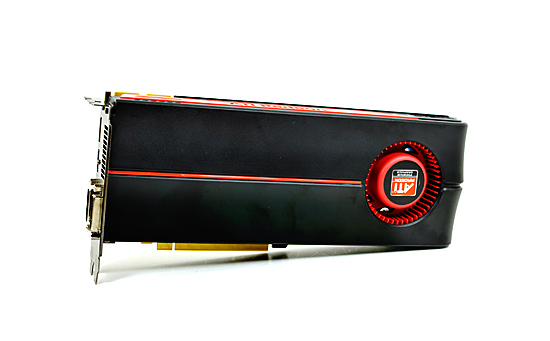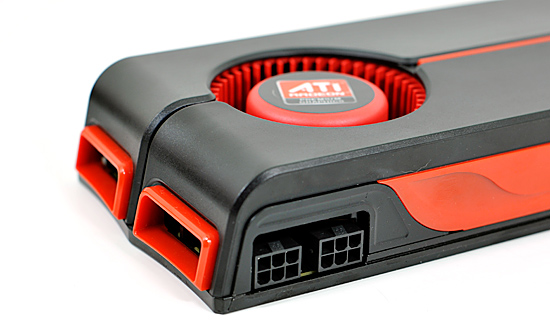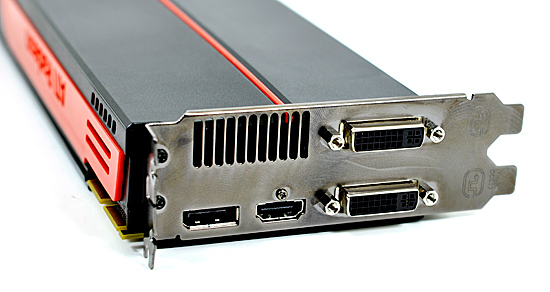AMD's Radeon HD 5870: Bringing About the Next Generation Of GPUs
by Ryan Smith on September 23, 2009 9:00 AM EST- Posted in
- GPUs
Meet the 5870
The card we’re looking at today is the Radeon HD 5870, based on the Cypress core.

Compared to the Radeon HD 4870, the 5870 has seen some changes to the board design. AMD has now moved to using a full sheath on their cards (including a backplate), very much like the ones that NVIDIA has been using since the 9800GTX. The card measures 10.5” long, an inch longer than the 4890 or the same as the 4870x2 and the NVIDIA GTX lineup.
The change in length means that AMD has moved the PCIe power connectors to the top of the card facing upwards, as there’s no longer enough room in the rear. Facing upwards is also a change from the 4870x2, which had them facing the front of the card. This, in our opinion, makes it easier to plug and unplug the PCIe power connectors, since it’s now possible to see what you’re doing.
Since the card has a TDP of 188W, AMD can still get away with using two 6-pin connectors. This is going to be good news for those of you with older power supplies that don’t feature 8-pin connectors, as previously the fastest cards without 8-pin connectors were the 4890 and GTX 285.

Briefly, the 5850 that we are not testing today will be slightly smaller than the 5870, coming in at 9.5”. It keeps the same cooler design, however the PCIe power connectors are back on the rear of the card.
With the 5800 series, DisplayPort is getting a much-needed kick in the pants. DisplayPort (full size) is standard on all 5800 series cards – prior to this it has been rather absent on reference cards. Along with a DisplayPort, the 5870 reference card contains a dedicated HDMI port, and a pair of DVI ports.
Making 4 ports fit on a card isn’t a trivial task, and AMD has taken an interesting direction in making it happen. Rather than putting every port on the same slot of the bracket as the card itself, one of the DVI ports is raised on to the other bracket. ATI could have just as easily only equipped these cards with 1 DVI port, and used an HDMI-to-DVI adapter for the second port. The advantage of going this direction is that the 5800 series can still drive two VGA monitors when using DVI-to-VGA adapters, and at the same time having an HDMI port built in means that no special adapters are necessary to get an HDMI port with audio capabilities. The only catch to this specific port layout is that the card still only has enough TMDS transmitters for two ports. So you can use 2x DVI or 1x DVI + HDMI, but not 2x DVI + HDMI. For 3 DVI-derived ports, you will need an active DisplayPort-to-DVI adapter.
With the configuration AMD is using, fitting that second DVI port also means that the exhaust vent of the 5800 series cards is not the full length of the card as is usually common, rather it’s a hair over half the length. The smaller size had us concerned about the 5870’s cooling capabilities, but as you’ll see with our temperature data, even with the smaller exhaust vent the load temperatures are no different than the 4870 or 4850, at 89C. And this is in spite of the fact that the 5870 is rated 28W more than the 4870.

With all of these changes also comes some changes to the loudness of the 5870 as compared to the 4870. The 27W idle power load means that AMD can reduce the speed of the fan some, and they say that the fan they’re using now is less noticeable (but not necessarily quieter) than what was on the 4870. In our objective testing the 5870 was no quieter than any of the 4800 series cards when it comes to idling at 46.6dB, and indeed it’s louder than any of those cards at 64dB at load. But in our subjective testing it has less of a whine. If you go by the objective data, this is a push at idle and louder at load.
Speaking of whining, we’re glad to report that the samples we received do not have the characteristic VRM whine/singing that has plagued many last-generation video cards. Most of our GTX cards and roughly half of our 4800 series cards generated this noise under certain circumstances, but the 5870 does not.
Finally, let’s talk about memory. Despite of doubling just about everything compared to RV770, Cypress and the 5800 series cards did not double their memory bandwidth. Moving from the 4870 and it’s 900MHz base memory clock, the 5870 only jumps up by 33% to 1.2Ghz, in effect increasing the ratio of GPU compute elements to memory bandwidth.
When looking back at the RV770, AMD believes that they were not bandwidth starved on the cards that used GDDR5. And since they had more bandwidth than they needed, it was not necessary to go for significantly more bandwidth for Cypress. This isn’t something we can easily test, but in our benchmarks the 5870 never doubles the performance of the 4870, in spite of being nearly twice the card. Graphics processing is embarrassingly parallel, but that doesn’t mean it perfectly scales. The different may be a product of that or a product of the lack of scaling in memory bandwidth, we can’t tell. What’s for certain however is that we don’t have any hard-capped memory bandwidth limited situations, the 5870 always outscores the 4870 by a great deal more than 33%.










327 Comments
View All Comments
Zool - Sunday, September 27, 2009 - link
The speed of the on chip cache just shows that the external memory bandwith in curent gpus is only to get the data to gpu or recieve the final data from gpu. The raw processing hapenns on chip with those 10 times faster sram cache or else the raw teraflops would vanish.JarredWalton - Sunday, September 27, 2009 - link
If SD had any reading comprehension or understanding of tech, he would realize that what I am saying is:1) Memory bandwidth didn't double - it went up by just 23%
2) Look at the results and performance increased by far more than 23%
3) Ergo, the 4890 is not bandwidth limited in most cases, and there was no need to double the bandwidth.
Would more bandwidth help performance? Almost certainly, as the 5870 is such a high performance part that unlike the 4890 it could use more. Similarly, the 4870X2 has 50% more bandwidth than the 5870, but it's never 50% faster in our tests, so again it's obviously not bandwidth limited.
Was it that hard to understand? Nope, unless you are trying to pretend I put an ATI bias on everything I say. You're trying to start arguments again where there was none.
SiliconDoc - Sunday, September 27, 2009 - link
The 4800 data rate ram is faster vs former 3600 - hence bus width is running FASTER - so your simple conclusions are wrong.When we overlcock the 5870's ram, we get framerate increase - it increases the bandwidth, and up go the numbers.
---
Not like there isn't an argument, because you don't understand tech.
JarredWalton - Sunday, September 27, 2009 - link
The bus is indeed faster -- 4800 effective vs. 3900 on the 4890 or 3600 on the 4870. What's "wrong about my simple conclusions"? You're not wrong, but you're not 100% right if you suggest bandwidth is the only bottleneck.Naturally, as most games are at least partially bandwidth limited, if you overclock 10% you increase performance. The question is, does it increase linearly by 10%? Rarely, just as if you overclock the core 10% you usually don't get 10% boost. If you do get a 1-for-1 increase with overclocking, it indicates you are solely bottlenecked by that aspect of performance.
So my conclusions still stand: the 5870 is more bandwidth limited than 4890, but it is not completely bandwidth limited. Improving the caches will also help the GPU deal with less bandwidth, just as it does on CPUs. As fast as Bloomfield may be with triple-channel DDR3-1066 (25.6GB/s), the CPU can process far more data than RAM could hope to provide. Would a wider/faster bus help the 5870? Yup. Would it be a win-win scenario in terms of cost vs. performance? Apparently ATI didn't think so, and given how quickly sales numbers taper off above $300 for GPUs, I'm inclined to agree.
I'd also wager we're a lot more CPU limited on 5870 than many other GPUs, particularly with CrossFire setups. I wouldn't even look at 5870 CrossFire unless you're running a high-end/overclocked Core i7 or Phenom II (i.e. over ~3.4GHz).
And FWIW: Does any of this mean NVIDIA can't go a different route? Nope. GT300 can use 512-bit interfaces with GDDR5, and they can be faster than 5870. They'll probably cost more if that's the case, but then it's still up to the consumers to decide how much they're willing to spend.
silverblue - Saturday, September 26, 2009 - link
I suppose if we end up seeing a 512-bit card then it'll make for a very interesting comparison with the 5870. With equal clocks during testing, we'd have a far better idea, though I'd expect to see far more RAM on a 512-bit card which may serve to skew the figures and muddy the waters, so to speak.Voo - Friday, September 25, 2009 - link
Hey Jarred I know that's neither the right place nor the right person to ask, but do we get some kind of "Ignore this person" button with the site revamp Anand talked about some months ago?I think I'd prefer this feature about almost everything - even an edit button ;)
JarredWalton - Friday, September 25, 2009 - link
I'll ask and find out. I know that the comments are supposed to receive a nice overhaul, but more than that...? Of course, if you ignore his posts on this (and the responses), you'd only have about five comments! ;-)Voo - Saturday, September 26, 2009 - link
Great!Yep it'd be rather short, but I'd rather have 10 interesting comments than 1000 COMMENTS WRITTEN IN CAPS!!11 with dubious content ;)
SiliconDoc - Wednesday, September 30, 2009 - link
I put it in caps so you could easily avoid them, I was thinking of you and your "problems".I guess since you "knew this wasn't the right time or place" but went ahead anyway, you've got "lot's of problems".
Let me know when you have posted an "interesting comment" with no "dubios nature" to it.
I suspect I'll be waiting years.
MODEL3 - Friday, September 25, 2009 - link
Hi Ryan,Nice new info in your review.
The day you posted your review, i wrote in the forums that according to my perception there are other reasons except bandwidth limitations and driver maturity, that the 850MHz 5870 hasn't doubled its performance in relation with a 850MHz 4890.
Usually when a GPU has 2X the specs of another GPU the performance gain is 2X (of cource i am not talking about games with engines that are CPU limited or engines that seems to scale badly or are poor coded for example)
There are many examples in the past that we had 2X performance gain with 2X the specs. (not in all the games, but in many games)
From the tests that i saw in your review and from my understanding of the AMD slides, i think there are 2 more reasons that 5870 performs like that.
The day of your review i wrote to the forums the additional reasons that i think the 5870 performs like that, but nobody replied me.
I wrote that probably 5870 has:
1.Geometry/vertex performance issues (in the sense that it cannot generate 2X geometry in relation with 4890) (my main assumption)
or/and
2.Geometry/vertex shading performance issues (in the sense that the geometry shader [GS] cannot shade vertex with 2X speed in relation with 4890)(another possible assumption)
I guess there are synthetic benchmarks that have tests like that (pure geometry speed, and pure geometry/vertex shader speed, in addition with the classic pixel shader speed tests) so someone can see if my assumption is true.
If you have the time and you think that this is possible and you feel like it is worth your time, can you check my hypothesis please?
Thanks very much,
MODel3